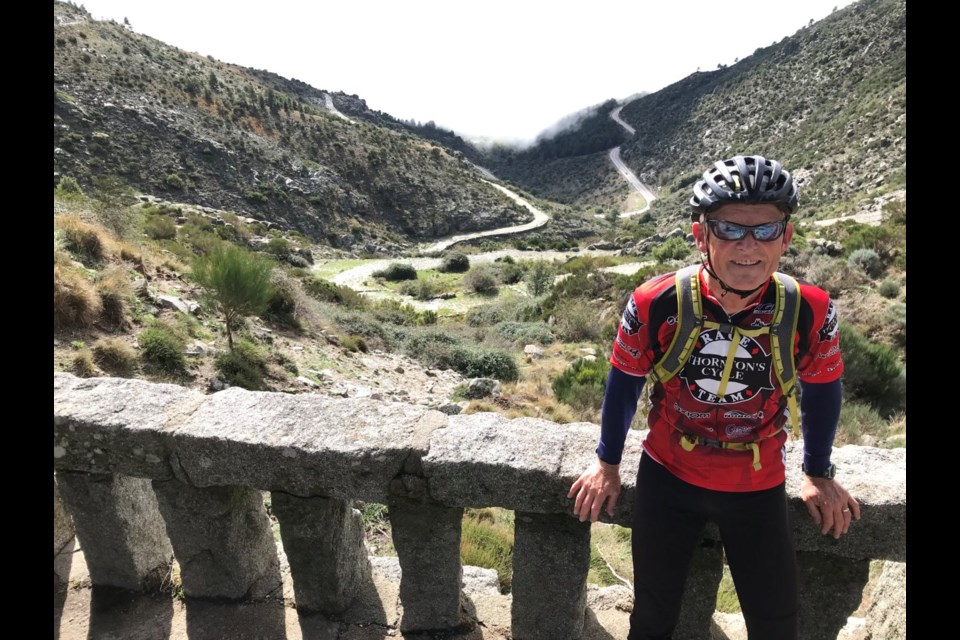This way, over here,” yelled a complete stranger as Mart and I approached Alcantara’s Plaza Mayor. He assumed we were members of his company’s group bike tour, and invited us to join them for lunch. We explained we were on our own, entered the bar, saw the cycling group in a windowless back room, and chose instead to grab stools at the busy bar to watch the world go by.
Mart and I reflected on how easy it had been to put together our own self-supported and self-guided trip, and the staggering cost difference.
Excluding flights, commercial bike tours in Spain offering mid-level hotels and some meals cost approximately C$500 to C$600/day. Adding ‘premium’ hotels and all meals increases costs to C$800 to C$900/day. Our ride, including average hotels, meals and sufficient drinks to overcome the aches and pains of wet hilly riding, cost less than C$150/day.
Route planning had been straightforward. A paper Michelin international map provided the big picture of central Spain. Its legend helped us understand road designation nomenclature, road surfaces, anticipated traffic levels, etc., all of which could then be applied to better utilize Google Maps.
Surprises were avoided by using Ride with GPS to calculate accurate distances and climbing elevations. Google Maps gave us road network details, accommodation locations, food sources, bicycle shops, everything we might need. By changing layers to Street View we could check road surface conditions and shoulder width to plan the safest routes.
We pre-booked a hotel in Madrid with shuttle service to ease flight connections. We had an idea of our daily destinations, but wanted the flexibility to change plans if we chose, so we decided to make reservations as we rode, searching options and booking by phone an hour or a day in advance.
Moving on: Merida and Caceres, both Unesco World Heritage sites
Merida is home to Roman, Moorish and Christian archeological sites, plus the National Museum of Roman Art.
The city, built by the Romans as Emerita Augusta in the first century BCE, includes a 14,000-seat amphitheatre for gory gladiatorial combat, and the Teatro Romano, an incredible 6,000-seat structure of stages, columns, and statues to provide more refined entertainment. While witnessing these adjacent marvels in person, it was almost impossible to believe that they had been abandoned for centuries and became buried under mud and debris until being rediscovered and restored in the early 1900s.
A half-kilometre away, guarding the 792-metre long, 60-arch Puente Romano over the Rio Guadiana, sits the Alcazabar, a 9th century fortress built by the Muslim Umayyad Caliphate.
When Christian King Alfonso IX of Leon recaptured Merida in 1230 BCE he built the Basilica of Santa Eulalia to re-assert Christianity, the primary religion of the region to this day.
As beautiful and peaceful as the valley is, our minds were on the climbs required to reach the walled city of Avila
Caceres, the capital of Extramadura, combines its Unesco World Heritage site with a vibrant food and entertainment sector. When you stay in a hotel named Hotel Soho Boutique Casa Don Fernando located on the Plaza Mayor, you might reasonably expect all your bases are covered.
A random weathered poster made me aware of the Helga de Alvear Museum of Contemporary Art, completed in 2019 and now home to 3000 works. There were no tickets available for the evening, but when I appeared at the entrance and pathetically told them I’d ridden my bicycle all the way from Madrid, uphill in the rain, to see the exhibit, I was allowed in. Perhaps because of my helmet-disheveled hair, bike tights, and weird cycling shoes, young security women tracked me in and out of every room. The main exhibition was breathtaking, and apparently I eventually passed security scrutiny. As I was exiting, I was invited to visit an exclusively female artist exhibit of 50 works being shown on another floor. Only when you’re on a bicycle...
Our final four riding days were spent twisting and turning amongst scrub forests and sparse grazing land on mountainside roads with stunning views into the fertile La Vera Valley. Olives, cherries, figs, grapes and paprika peppers grow along this rainy southern side of the Sierra de Gredos mountain range.
As beautiful and peaceful as the valley is, our minds were on the climbs required to reach the walled city of Avila, our boarding spot for the train to Madrid. Day 1 was a 520-metre warm-up climb, then 1050-, 1111-, and 1604-metre days followed in succession. For reference, that totals 14,000 feet, about the same vertical as climbing the Swiss Matterhorn.
Free castle anyone? As we entered the tiny village of Montbeltran, we couldn’t help but notice scruffy Montbeltran Castle perched forlornly above the road. The medieval castle was given to the Duke of Albuquerque in 1461 by Spanish King Enrique IV, but the Duke couldn’t afford to maintain it so he donated it to his home town of Albuquerque, which is 300 kilometres away and also couldn’t afford it. Word on the street is that if you promise to restore and maintain the castle, it’s yours for free.
We survived the migrating vultures of rugged Parc Nacional de Monfrague and managed the final climb to the walled city of Avila. Our off-season arrival allowed us the guilty pleasure of riding our bikes directly to the red-carpeted doorsteps of the now-affordable Hotel Palacio Valderrabanos, spectacularly located between the Cathedral de Avila and the palace after which it is named.
Marble staircases, brass railings, walls covered with imposing golden-framed artwork, and to the incredulous stares of the few other guests present, we were allowed to carry our bikes up to our rooms! What better ending could one write for our eye-opening Extramadura cycling adventure?
Last of three parts. Want to try planning your own cycling adventure? Start with a two- or three-day trip in Ontario to familiarize yourself with the process, then expand your horizons as you feel comfortable. Have fun!



